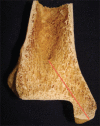Medial Malleolar Fractures: An Anatomic Survey Determining the Ideal Screw Length
- PMID: 28503349
- PMCID: PMC5414444
- DOI: 10.4103/amhsr.amhsr_41_16
Medial Malleolar Fractures: An Anatomic Survey Determining the Ideal Screw Length
Abstract
Background: Medial malleolar fractures are frequent, and their treatment is familiar to the orthopedic surgeon. Lag screw fixation using partially threaded screws remains the standard treatment method for medial malleolar fractures. However, the literature lacks a defined method for selecting lag screw length, relying more so on the empiric choice of the surgeon.
Aim: The aim of this study is to help define the ideal lag screw length for medial melleolar fracture fixation.
Materials and methods: One hundred and sixteen anatomic specimens were included in the study. A transverse cut was performed in the distal third of the tibia, roughly 1 and a half times the distal tibial plafond width from the ankle joint. A coronal cut was then performed using the center of the medial malleolus. Three observers measured the distance between the medial malleolus tip and beginning of the medullary canal in all anatomic specimens. Differences in measurements were statistically compared, level of (P ≤ 0.05). Interclass correlation coefficient (ICC) significance level was set at P < 0.05.
Results: Measurement average was 55 mm between the medial malleolus tip and the medullary canal, with a standard deviation of 10 mm. High concordance (ICC: 0.819) was achieved among all pairs of observers (P < 0.01). The systematic difference among measurements was absent, and random distribution around general measurements was observed.
Conclusion: The authors recommend a screw length of no more than 45 mm to optimize the location of the screw threads in the best cancellous bone in an effort to obtain the most compression.
Keywords: Ankle; ankle fractures; medial malleolus.
Conflict of interest statement
There are no conflicts of interest.
Figures
References
-
- Reinherz RP, Granoff SR, Henning KE, Ross BS. Characteristics and operative management of supination external rotation ankle fractures. J Foot Surg. 1991;30:356–63. - PubMed
-
- Pagliaro AJ, Michelson JD, Mizel MS. Results of operative fixation of unstable ankle fractures in geriatric patients. Foot Ankle Int. 2001;22:399–402. - PubMed
-
- Parker L, Garlick N, McCarthy I, Grechenig S, Grechenig W, Smitham P. Screw fixation of medial malleolar fractures: A cadaveric biomechanical study challenging the current AO philosophy. Bone Joint J. 2013;95-B:1662–6. - PubMed
-
- Hahn DM, Colton CL. Malleoli. In: Rüedi TP, Buckley RE, Moran CG, editors. AO Principles of Fracture Management. 2nd ed. Vol. 2. Davos, Switzerland: AO Publishing; 2007. p. 888.
-
- Hak DJ, Lee MA. Ankle fractures: Open reduction internal fixation. In: Wiss DA, editor. Master Techniques in Orthopaedic Surgery: Fractures. Master Techniques in Orthopaedic Surgery. 2nd ed. Philadelphia: Lippincott Williams and Wilkins; 2006. pp. 556–7.
LinkOut - more resources
Full Text Sources
Other Literature Sources


